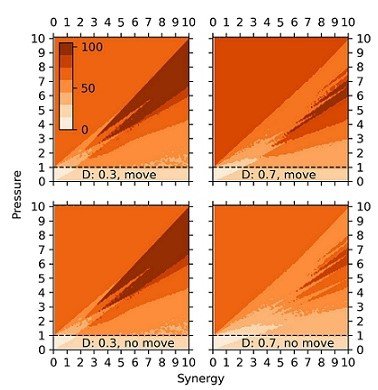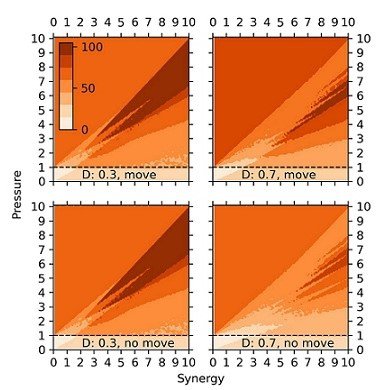Multilevel Group Selection I (1.6.1)
New theoretical agent-based model of population-wide adoption of prosocial common-pool behavior with four parameters (initial percent of adopters, pressure to change behavior, synergy from behavior, and population density); dynamics in behavior, movement, freeriding, and group composition and size; and emergence of multilevel group selection. Theoretical analysis of model’s dynamics identified six regions in model’s parameter space, in which pressure-synergy combinations lead to different outcomes: extinction, persistence, and full adoption. Simulation results verified the theoretical analysis and demonstrated that increases in density reduce number of pressure-synergy combinations leading to population-wide adoption; initial percent of contributors affects underlying behavior and final outcomes, but not size of regions or transition zones between them; and random movement assists adoption of prosocial common-pool behavior.

Release Notes
Cleaned up parts of the code, introduced the initial-pressure parameter, and introduced the following plots: Mean payoff of agents, Between- vs. within-group selection, Percent of agents that are freeriders, Percent of agents exposed to within-group selection, Percent of agents exposed to between-group selection, Assortativity among contributors, and Assortativity among non-contributors.
Associated Publications
https://doi.org/10.1080/0022250X.2021.2021513
This release is out-of-date. The latest version is
2.0.0
Multilevel Group Selection I 1.6.1
Submitted by
Garry Sotnik
Published Sep 26, 2020
Last modified Dec 05, 2024
New theoretical agent-based model of population-wide adoption of prosocial common-pool behavior with four parameters (initial percent of adopters, pressure to change behavior, synergy from behavior, and population density); dynamics in behavior, movement, freeriding, and group composition and size; and emergence of multilevel group selection. Theoretical analysis of model’s dynamics identified six regions in model’s parameter space, in which pressure-synergy combinations lead to different outcomes: extinction, persistence, and full adoption. Simulation results verified the theoretical analysis and demonstrated that increases in density reduce number of pressure-synergy combinations leading to population-wide adoption; initial percent of contributors affects underlying behavior and final outcomes, but not size of regions or transition zones between them; and random movement assists adoption of prosocial common-pool behavior.
Release Notes
Cleaned up parts of the code, introduced the initial-pressure parameter, and introduced the following plots: Mean payoff of agents, Between- vs. within-group selection, Percent of agents that are freeriders, Percent of agents exposed to within-group selection, Percent of agents exposed to between-group selection, Assortativity among contributors, and Assortativity among non-contributors.

